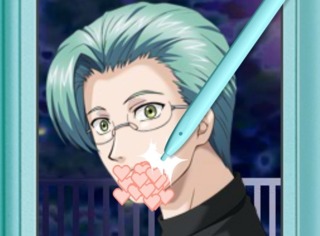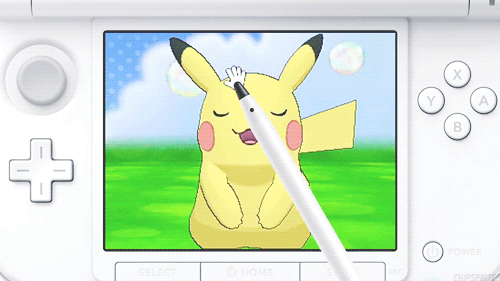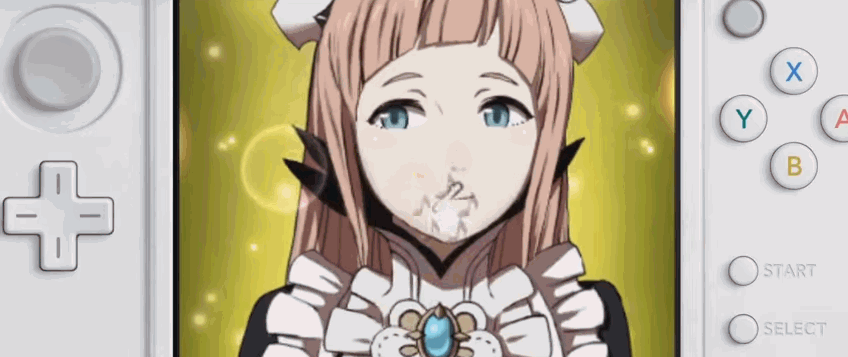
Though the upcoming release of Fire Emblem Fates has put “skinship” in the news lately, I first encountered the term years ago, while playing Tokimeki Memorial Girl's Side: 2nd Kiss. At first I thought it was amazingly awkward. There was my character, walking home with her boyfriend in the evening, reaching out to poke and prod and stroke his face while they carried on a conversation. And there I was, tapping away at an anime man's face on a screen about the size of a credit card, seriously re-evaluating my life choices. It felt absurd... But it also felt more engaging than most of the other dating sims, otome games, and visual novels that I had played before.
So I'll be honest and admit that my interest in Fire Emblem Fates waned when I heard that the North American version wouldn’t allow players to pet their companions between battles exactly as they could in the original Japanese version. It might seem silly to be upset about losing such a seemingly out-of-place feature in a strategy game, but it mattered to me. Skinship mechanics have a somewhat seedy reputation as something designed simply to court folks who want to grab at anime ladies. Sure enough, if that's what you're into then the skinship system in the Japanese version of Fire Emblem Fates would deliver, and in that context I can understand why there’s been so much debate surrounding its removal.
But the fact is that there's a lot more to skinship than titillation, which may explain how it's strayed from the genres it originated in and found its way into games like Fire Emblem and even Pokemon. At their core skinship mechanics serve a very honest and very human purpose, and there’s a chance that the changes made to the newest Fire Emblem may actually serve that purpose better.
Skinship, The Most Lovecraftian Romance Term
Before it was ever used to refer to a game feature, the term skinship was coined in Japan as a play on the english word “kinship” and was initially used to describe nurturing, parental contact. Over time the literal meaning broadened but the spirit remained the same; the point is that under the right circumstances this kind of contact--be it holding hands with someone or kissing them or even brushing their hair--naturally has an effect that can strengthen the bond between two people, whether their relationship is romantic or not. It's the joy that can come from both being cared for or caring for another.

In games, skinship tends to involve physically touching the image of a character with a cursor, a stylus, or even their finger in order to generate a positive response from them. At its most absurd, players are rewarded with affection-like currency for literally poking someone in the exact right spot--maybe their shoulder or maybe their cheek--over and over again, while hearts and glitter gush across the screen.
You know, love.
Skinship typically excludes dialogue options or buttons that trigger some kind of interaction because it's fundamentally about direct person-to-person (or player-to-character) contact, and the further removed the simulated experience is from that the less relevant it becomes. At its most basic, this is a way for the player to demand a reaction to them and not just to the game's more rigidly scripted events and actions.
Skinship flourished among Japanese visual novels, otoge and eroge since those games tend to be the ones most concerned with relationships and intimacy. They also tend to feel less embodied than a game where the player has fluid control of their virtual self within a virtual space. Instead players are presented with screens and stills, so restoring that sense of embodiment can be even more of a priority. The proliferation of touchscreen devices like the DS, 3DS, Vita, and of course smartphones have increased skinship's popularity in games by making it a two-birds-with-one-stone kind of thing: Developers can differentiate their game from its competition on non-touch platforms while simultaneously getting all the benefits of simulated face touching.
Video games have always struggled with effectively representing intimacy: Regardless of how well-developed a relationship between the player and a given character is, or what that player can be made to feel for that character through writing or plain old aesthetic attraction, it's next to impossible to bridge the gap of physical contact because of the nature of video games themselves. No matter how much a player may want to reach for a character's hand they just can't. For a medium that relies on interactivity almost by definition, this isn't an insignificant issue for developers to pursue at least as much as they might pursue improving how a gun feels or how the grass looks.
Yet many of the methods used to address the issue can fall short. A players may be shown a simulation of themselves acting, but there will always be a very real distance between them and that action. Once initiated, this animation or CG scene or whatever it may be typically proceeds with little or no further input, meaning that the player’s involvement (and investment) is likely going to be limited. So while the idea of rubbing a character's torso on a touch screen may seem silly or frivolous, compare it to Kratos' QTE sex scenes and you might start to see the merit in its directness.

Of course you don't need to pet a character like a cat (or a Meowth, in the very literal case of Pokemon Amie) in order to feel engaged or attached to them either, and obviously simulated rubdowns aren't going to have a place in every game. Skinship mechanics are one tool in a toolbox, and just like any other tool their efficacy boils down to knowing both when and how to use them. Sometimes, though, developers don’t know how to use those tools, and the results can lead to a lot of doubt about their value.
Ok... but this is just a sex thing, right?
Imagine a spectrum: On the left side of this spectrum you have games that treat their characters as individuals with wants and needs, and on the right you have games that treat them as toys, person-shaped playthings. One way to think about this spectrum is to apply the concept of “diegetic” content. In movies, the term “diegetic” refers to music or sound that can be heard by characters, as opposed to “non-diegetic” effects that can only be heard by the audience. Consider the opening of the first episode of Life is Strange as Max put in her earbuds and walks down the hallway, and you have a prime example of diegetic music.
This same distinction can be used when talking about touching digital characters. “Diegetic interaction” is the kind of thing I've mostly been talking about up until now. It’s an interaction with a character's body that they are aware of and acknowledge. Maybe, for example, I boop a character’s nose and they laugh, or I jab them in the eye and they leave because I’m being kind of a dick. “Non-diegetic interaction”, on the other hand, is an interaction with a character's body that goes completely unnoticed. One of the most prominent examples of non-diegetic interaction I can give is the way players can manipulate Rose's breasts with the analog sticks in Metal Gear Solid 4. One can assume if that were somehow actually happening (because, I don't know, nanomachines?), Rose would still feel it and react in some way. But she doesn't; she carries on talking regardless. Rose as a character exists for many reasons, but that particular mechanic presents her physically as a plaything for the player, independent of everything else happening in the game. She can't even flinch. If we're discussing why skinship mechanics often have a bad reputation, this kind of interaction is our foundation.
One step closer to the other side of the spectrum are prompts that make a character react superficially, giving a bit of a performance without any consequences or measurable results. This appears in all kinds of games, and if you ever had a stint playing with KiSS dolls or Flash dressup games (… or Dragon's Crown), then you've certainly had a brush with these simplistic gestures towards physicality too. Even if you don't find them enticing, there is often a novelty to be had: Sometimes we click just because we can, just to see what will happen, not because we’re seeking any actual gratification out of it.
For me, skinship mechanics are at their best when they’re well situated and contextualized within the game. Consider Duel Love, a Japanese otome game for the DS which got a ton of publicity a few years back for the sections that allowed the player to towel sweat off of their favourite handsome anime boy. Less widely publicized was the fact that the game was about dating athletes, and part of that involved taking care of their injuries, giving them backrubs, and yes, towelling them off. Yes, it’s still a very cheesecakey game, but it also demonstrates that skinship can be truer to the term's origin than poking at a picture of a face in some pastiche of human affection.
That's nice, but what's up with Fire Emblem?
Although there has been a lot of confusion on the subject leading up to its North American release, skinship hasn't been completely removed from the North American release of Fire Emblem Fates. Early reports reveal that there are still events where a player will be asked to caress their spouse's face to wake them, blow into the 3DS microphone to cool them off, and so on. What has been removed is the ability to invite friends and family into your room for a vigorous post-battle rub-down (just like friends do, right?) apropos of almost nothing.
Even as a big fan of skinship features, I can admit that this change is far from the game-ruining scenario that I thought it was when I first heard about it. It might even be an improvement in a sense. It seems like the mechanics are still in place to encourage a simulation of physical closeness in a relevant and meaningful context, while the more awkward elements are the ones that ended up on the cutting room floor. In this sense Fire Emblem Fates' North American version may have actually found the best possible compromise.
Skinship might seem out of place in a strategy game, but its inclusion in Fire Emblem Fates seems like an acknowledgment that personal relationships are a significant part of what makes the series so special. There's a reason that Fire Emblem Awakening has such a die-hard following among players who wouldn't usually reach for military strategy games.

Let's not mince words: Skinship mechanics are an often inelegant solution to the problem of direct interaction between a player and a character. They're not even really a solution at all so much as an awkward stopgap measure to which there are few alternatives. Yet that awkward (and sometimes creepy) stopgap is experiencing a renaissance due in no small part to the proliferation of touchscreen-based gaming, which makes those actions even more direct and more personal than they once were. Elegant or not, they fulfill a purpose. Sometimes cutscenes are good enough, and sometimes they're not. Watching my Inquisitor and her beau interacting in Dragon Age: Inquisition absolutely made me happy, but there was still a very real disconnect between me and them. Not me and him, but me and them.
For decades we’ve been sitting in front of screens, engaging with even the most compelling digital representations of other people through our cursors and keypresses alone. Positioning skinship as a mechanic only meant to titillate ignores the fact that it tries to satisfy one of the most human needs imaginable. And there's nothing wrong with trying to fulfill that need, just like there’s nothing wrong with trying to make a game’s graphics look more realistic or more stylistic. Despite their sometimes awkward implementation, skinship mechanics aim to breach a gap games have always struggled with. They let the player reach out to someone or something that the game wants them to connect with, and in turn that someone or something provides some small acknowledgment of the player's physical being. It's not elegant enough to keep it from being a bit of a punchline, but it's the best we've got... Until someone hires Robert Yang, anyway.
Janine Hawkins is a games critic based in sunny Canada who enjoys Style Savvy and third-person shooters with equal gusto. You can find her on Twitter @bleatingheart, or catch her on video at www.streamfriends.tv. Make sure to listen to her chat with Austin on the most recent episode of Giant Bomb Presents!